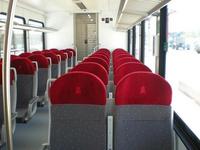Light rail priority for Legislature
June 8, 2009
If the Texas Legislature had a message this just-ended session about the future of state transportation, it is that intercity passenger rail will be part of the mix.
Written by David Hendricks, The San Antonio Express-News

If the Texas Legislature had a message this just-ended session about the future of state transportation, it is that intercity passenger rail will be part of the mix.
Lawmakers said it three different ways.
* The new two-year state budget includes $182 million for freight rail relocation, which could free up tracks for passenger rail. The allocation is the first since state voters approved the concept several years ago. Rail relocation also has a safety purpose, moving rail freight out of dense urban areas.
* The Legislature further allocated $8.7 million for environmental clearance and preliminary engineering of the 110-mile San Antonio-Austin passenger rail project.
* Gov. Rick Perry was sent a bill that calls for the Texas Department of Transportation to develop a statewide passenger rail transportation plan.
No trains are leaving the station yet. Much more must happen first.
The rail relocation funding, for one thing, falls far short of what is needed. Several rail relocation projects around the state can compete for that funding, said Ross Milloy, director of the Greater Austin-San Antonio Corridor Council.
By allocating the additional $8.7 million, though, the Legislature clearly is signaling to TxDOT that the San Antonio-Austin passenger rail project is the top priority.
TxDOT already is studying several route alternatives to relocate Union Pacific Corp.'s tracks between San Antonio and Austin. The preliminary cost estimate is $1.7 billion, said Milloy, who as corridor director also provides staff support to the Austin-San Antonio Intermunicipal Commuter Rail District.The $182 million rail relocation fund can be multiplied many times if it can be transformed into a bond program. The state must find a way to convince the capital markets that the Legislature will continue to add funding in future sessions, Milloy explained, so that land can be purchased and tracks laid.
TxDOT and Union Pacific have signed an agreement that would require the state to pay the share of relocation costs that benefit the public, such as fewer urban rail crossings, reduced exposure to hazardous freight and less traffic on Interstate 35. The railroad company would pay for the portion that would improve and speed up freight deliveries.
The public benefit portion has been estimated at $1.4 billion, Milloy said. Whether Union Pacific would pay the remaining $300 million or so must be negotiated, he added.
Meanwhile, the Austin-San Antonio Intermunicipal Commuter Rail District continues to explore opportunities for federal economic stimulus funding to help pay for passenger rail station construction and the train equipment. President Barack Obama announced in April his support for a national high-speed passenger rail network.
“It's not everything we wanted, but it's pretty good,” Milloy said of the $182 million rail relocation funding, citing the work of state Rep. Ruth Jones McClendon, D-San Antonio. McClendon inserted the funding during a lengthy Texas House budget session in April. “Everyone in the corridor owes her a great debt,” Milloy said.
Finally, there is talk of changing the clunky rail district name to start developing a brand identity. “We are changing from an organizing agency to an operating agency,” Milloy said.
If all goes well, rail passenger service could begin as early as 2012.
![]()
![]()
Related Stories
![]()
Fair Use Notice
This site contains copyrighted material the use of which has not always been specifically authorized by the copyright owner. We are making such material available in our efforts to advance understanding of environmental, political, human rights, economic, democracy, scientific, and social justice issues, etc. We believe this constitutes a "fair use" of any such copyrighted material as provided for in section 107 of the US Copyright Law. In accordance with Title 17 U.S.C. Section 107, the material on this site is distributed without profit to those who have expressed a prior interest in receiving the included information for research and educational purposes. For more information go to: http://www.law.cornell.edu/uscode/17/107.shtml. If you wish to use copyrighted material from this site for purposes of your own that go beyond "fair use", you must obtain permission from the copyright owner.